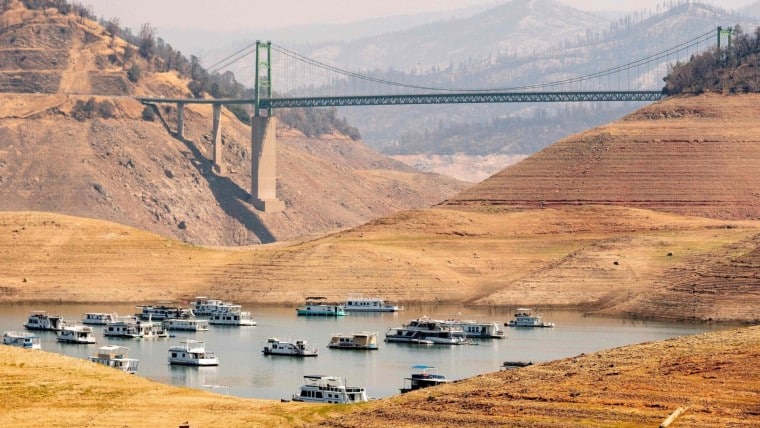LOS ANGELES (AP) — Southern California’s water giant took the unprecedented step Tuesday of requiring some 6 million people to reduce outdoor watering to one day a week as a drought continues to rage. the state.
The Metropolitan Water District of Southern California’s board declared a water shortage emergency and required cities and water agencies they serve to implement the cut by June 1 and enforce it or face heavy fines.
“We don’t have enough water supplies right now to meet normal demand. The water is not there,” said Rebecca Kimitch, a spokeswoman for the Metropolitan Water District. “This is unprecedented territory. We’ve never done anything like this before.”
The Metropolitan Water District uses water from the Colorado River and the State Water Project to supply 26 public water agencies that provide water to 19 million people, or 40 percent of the state’s population.
But record dry conditions have strained the system, lowering reservoir levels, and the State Water Project, which gets its water from the Sacramento-San Joaquin River Delta, has estimated it will only be able to deliver about 5 percent percent of your usual allowance this year. .
January, February and March of this year were the three driest months in the state’s recorded history in terms of rainfall and snowfall, Kimitch said.
The Metropolitan Water District said that the 2020 and 2021 hydrographic years had the least amount of rainfall recorded for two consecutive years. In addition, Lake Oroville, the main reservoir for the State Water Project, reached its lowest point last year since it was filled in the 1970s.
California Governor Gavin Newsom has asked people to voluntarily reduce their water use by 15 percent, but residents have so far been slow to meet that goal.
Several water districts have instituted water conservation measures. On Tuesday, the East Bay Municipal Utilities District board voted to reduce water use by 10 percent and limit daily use for some 1.4 million customers in Contra Costa and Alameda counties, including Oakland. and Berkeley. Households will be able to use 1,646 gallons a day, well above the average household use of about 200 gallons a day, and the agency expected only 1 percent to 2 percent of customers to exceed the limit, the San Francisco Chronicle reported. .
The Metropolitan Water District’s restrictions apply to areas of Los Angeles, Ventura and San Bernardino counties that rely primarily on state water supplied through the district, including some parts of the city of Los Angeles. Mainly urban areas are affected.
MWD client water agencies must implement the one-day-a-week outdoor use restriction or find other ways to make equivalent reductions in water demand, Kimitch said.
Although water agencies support the water conservation movement, it remains to be seen whether the public will, Kimitch said.
The Metropolitan Water District will monitor water use and, if the restrictions don’t work, could order a complete ban on outdoor watering starting in September, he said.
Meanwhile, state lawmakers have taken the first step toward lowering the standard for how much water people use in their homes.
The current California standard for residential indoor water use is 55 gallons per person per day. The rule does not apply to customers, which means that regulators do not issue fines to people for using more water than allowed. Instead, the state requires water agencies to meet that standard for all of their customers.
But the state Senate voted overwhelmingly last week to lower the standard to 47 gallons per person per day beginning in 2025 and 42 gallons per person per day beginning in 2030.
The bill has yet to pass the Assembly, meaning it is likely months away from becoming law.
The western US is in the midst of a severe drought just a few years after record rainfall and snowfall filled reservoirs to capacity. Scientists say this boom-and-bust cycle is driven by climate change that will be marked by longer and more severe droughts. A study from earlier this year found that the western US was in the midst of a mega-drought that is now the driest in at least 1,200 years.
Reference-www.nbcnews.com
